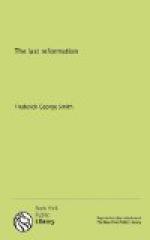It is clear, however, that the woman signifies, not a single individual, but the church. Therefore the child born of her must simply signify another phase of the church but the same family. By means of this twofold symbol—involving the closest relationship known—is set forth the fruitfulness and perpetuity of the church. There is also another reason why a double symbol should be selected to set forth the true church—to represent two distinct phases of the church’s life and history, which, in the nature of the case, could not be represented under a single symbol. According to the description given, the man child was caught up to God and to his throne, while the woman remained on earth and fled into the wilderness, where she had a place prepared of God for 1,260 days. The man child, then, represents that phase of the church which was caught up from the earth but ascended to heaven and there lived and reigned with Christ; while the woman represents that phase of the church which continued on earth and fled into the wilderness during the period of the great apostasy.
There is also direct Scriptural testimony justifying this interpretation of the man child. In Isaiah 66 we have a sublime description of Zion, God’s church and people, represented as a woman, a mother. The context shows that this scripture is a prophetic allusion to the church of the New Testament age. “Before she travailed, she brought forth; before her pain came, she was delivered of a man child. Who hath heard such a thing? who hath seen such things? Shall the earth he made to bring forth in one day? or shall a nation be born at once? for as soon as Zion travailed, she brought forth her children” (verses 7, 8). Here Zion is represented as a mother bringing forth a man child, but this is interpreted to be a nation born at once. According to Heb. 12:22, 23, this Zion, or Sion, represents the New Testament church. There is no doubt, then, that the man child of Revelation 12 refers to the great host of new converts with which the early church was blessed. The scripture in Isaiah just cited met its fulfilment on the day of Pentecost and shortly afterwards, when thousands were brought into the church in a day. The apostle Paul also refers to the great company of Jews and Gentiles who were reconciled to God as constituting "one new man” in Christ (Eph. 2:15).




